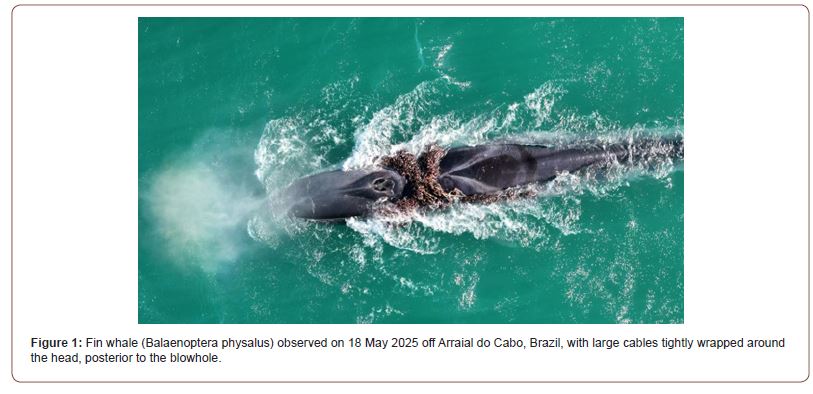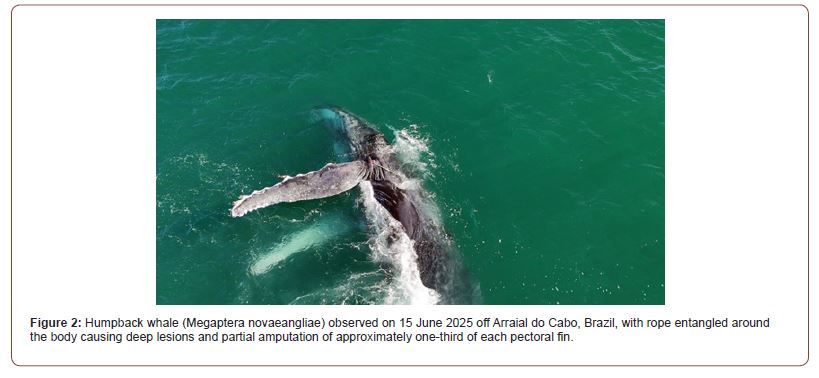 Short Communication
Short Communication
Entanglement of Fin and Humpback Whales in Arraial do Cabo, Brazil: Emerging Challenges
Yaci Gallo Alvarez1,2*, Dora Barbalho Barreiros2, Thadeu Burached Dias da Silva2,3, Marcelo Francisco de Lima2, Sarah Rodrigues Pessoa2,3, Katia Regina Valente Medeiros Ferreira2,3, and Jan Giorgio Nunes Lobo2
1Programa de Pós-Graduação Dinâmica dos Oceanos e da Terra, Instituto de Geociências, Universidade Federal Fluminense, Av. Gen. Milton Tavares de Souza, Gragoatá, Campus da Praia Vermelha, Niterói, RJ, Brazil
2Fundação Municipal de Meio Ambiente, Pesquisa Ciência, Tecnologia, Esporte e Lazer de Arraial do Cabo, FUNTEC Ambiental, Rua Almirante Tamandaré, Canaãa, Arraial do Cabo, RJ, Brazil
3Instituto Federal do Rio de Janeiro, Campus Arraial do Cabo, R. José Pinto de Macedo, Prainha, Arraial do Cabo, RJ, Brazil
Yaci Gallo Alvarez, Fundação Municipal de Meio Ambiente, Pesquisa, Ciência, Tecnologia, Esporte e Lazer de Arraial do Cabo – FUNTEC Ambiental Rua Almirante Tamandaré, Canaã, Arraial do Cabo, RJ, Brazil
Received Date:September 17, 2025; Published Date:September 23, 2025
Abstract
Between 2024 and 2025, several cases of whale entanglements were documented off Arraial do Cabo, southeastern Brazil, through the landbased monitoring program Projeto Mar de Baleias. Records included humpback whales (Megaptera novaeangliae) entangled in ropes and anchoring systems, as well as a fin whale (Balaenoptera physalus) severely entangled in heavy cables around the head. In some events, whales managed to free themselves, while in others deep injuries were observed, including partial loss of pectoral fins. The fin whale case was particularly concerning due to the animal’s weakened body condition and malnutrition. These observations were supported by citizen science reports and aerial drone monitoring. The records highlight the growing overlap between whale migratory routes and human activities along the Brazilian coast and underscore the need for measures to mitigate anthropogenic risks to large whales and underscore the need for integrated conservation strategies involving rapidresponse disentanglement, citizen science, and environmental education.
Keywords:Marine mammal conservation; anthropogenic interactions; fishing gear entanglement; coastal management; cetacean monitoring
Introduction
Entanglement in ropes, nets, and anchoring systems is one of the primary anthropogenic threats to baleen whales, causing injuries, reduced mobility, and significant consequences for survival and population recovery [1-3]. Humpback whales (Megaptera novaeangliae) are the most frequently reported species in Brazilian waters due to their extensive coastal migration between Antarctic feeding grounds and breeding grounds in the northeast Brazil [4]. Fin whales (Balaenoptera physalus) are rare along the Brazilian coast, usually sighted alone or in pairs, with a few strandings and historical whaling records reported [5-7]. Arraial do Cabo, located in southeastern Brazil, is part of an important migratory corridor for baleen whales. The region experiences intensive human use,including navigation, tourism, anchoring, and artisanal fishing. This spatial overlap between whales and human activities increases the likelihood of interactions and entanglement events [8]. In this study, we report entanglement cases documented between 2024 and 2025, highlighting their ecological significance for individual health and survival, and illustrating the conservation challenges for marine mammal management in Brazilian waters.
Discussion
Between 2024 and 2025, six entanglement events were documented off Arraial do Cabo: four involving humpback whales (Megaptera novaeangliae) and two involving fin whales (Balaenoptera physalus). Outcomes ranged from minor entanglements resolved spontaneously to severe injuries. Two events were particularly concerning. On 18 May 2025, a fin whale was documented with large cables tightly wrapped around its head, just posterior to the blowhole. The animal exhibited signs of malnutrition, remained in sheltered waters for several hours, and later resumed migration toward deeper northern waters (Figure 1). Subsequently, on 15 June 2025, a humpback whale had a rope entangled around its body, causing deep lesions and partial amputation of approximately one-third of each pectoral fin (Figure 2). Despite the severity of the injuries, the whale remained active, performing multiple breaches, pectoral slaps, and rolling behaviors. Both entangled individuals (fin and humpback whales) were accompanied by conspecifics that appeared uninjured. These cases illustrate the serious consequences of entanglement for individual health, mobility, and survival [9,10].


Currently, disentanglement efforts in Brazil remain extremely limited, with only two specialized teams legally authorized and trained by competent authorities. Attempting disentanglement without proper training is prohibited, emphasizing the criticals importance of expanding and formally regulating this capacity. Citizen science initiatives have proven valuable for early detection and monitoring of entanglement events and should be integrated with broader conservation strategies [11]. These observations underscore the increasing spatial overlap between large whale migratory corridors and human activities, including navigation, anchoring, and tourism. They highlight the need for conservation strategies that integrate rapid-response disentanglement capacity, citizen science, and environmental education initiatives targeting local communities [8,11,12] and schools [13]. Furthermore, incorporating ocean literacy principles ensures that conservation measures are informed by human experience and local knowledge, fostering participatory approaches, enhancing awareness, and promoting sustainable interactions with marine ecosystems [13].
Conclusion
The 2024–2025 entanglement cases off Arraial do Cabo highlight the consequences of increased spatial overlap between baleen whales and human activities in Brazilian coastal waters. Conservation efforts should prioritize prevention through regulated anchoring, awareness among maritime users, and expansion of rapid-response disentanglement networks. Additionally, the development of public policies and environmental education programs targeting both local communities and schools is essential to raise awareness and promote long-term stewardship of marine ecosystems through community engagement and ocean literacy initiatives.
Acknowledgements
We thank the Prefeitura Municipal de Arraial do Cabo for supporting the cetacean monitoring program, the FUNTEC Ambiental team, specially Jênifer de Jesus, and volunteers for their dedication, and all members of the local community and schools for their invaluable contributions to citizen science activities within the Projeto Mar de Baleias.
Conflict of Interest
The authors declare no conflicts of interest.
References
- Reeves RR, Mcclellan K, Werner TB (2013) Marine mammal bycatch in gillnet and other entangling net fisheries, 1990–2011. Endangered Species Research 20(1): 71-97.
- Robbins J (2012) Scar-based inference into Gulf of Maine humpback whale entanglement: 1970–2009. NOAA Technical Memorandum NMFS-NE-223.
- Knowlton AR, Robbins J, Landry S, Mckenna HA, Kraus SD, et al. (2016) Effects of fishing rope strength on the severity of large whale entanglements. Conserv Biol 30(2): 318-328.
- Andriolo A, Kinas PG, Engel MH, Martins CC, Rufino AM (2010) Humpback whales within the Brazilian breeding ground: distribution and population size estimate. Endangered Species Research 11(3):233-243.
- Zerbini AN, Secchi ER, Siciliano S, Simões-Lopes PC (1997) A review of the occurrence and distribution of whales of the genus Balaenoptera along the Brazilian coast. Report of the International Whaling Commission 47: 407-417.
- Jefferson TA, Webber MA, Pitman RL (2008) Marine Mammals of the World: A comprehensive guide to their identification. London: Academic Press, PP. 573.
- Wedekin LL, Rossi-Santos MR, Baracho C, Cypriano-Souza AL, Simões-Lopes PC (2014) Cetacean records along a coastal-offshore gradient in the Vitória-Trindade Chain, western South Atlantic Ocean. Brazilian Journal of Biology 74(1): 137-144.
- Moore MJ, Andrews RD, Austin T (2021) Assessing cetacean entanglement injury and mortality risk from fixed fishing gear. Endangered Species Research 44: 1-16.
- Cassoff RM, Moore KM, Mclellan WA, Barco SG, Rotstein DS, et al. (2011) Lethal entanglement in baleen whales. Dis Aquat Organ 96(3): 175-185.
- Moore MJ, Van Der Hoop JM (2012) The painful side of trap and fixed net fisheries: chronic entanglement of large whales. Journal of Marine Biology 2012: 230653.
- Embling CB, Walters AEM, Dolman SJ (2015) How much effort is enough? The power of citizen science to monitor trends in coastal cetacean species. Global Ecology and Conservation 3: 867-877.
- Seminara CI, Barbosa-Filho MLV, Le Pendu Y (2019) Interactions between cetaceans and artisanal fishermen from Ilhéus, Bahia - Brazil. Biota Neotropica 19(4): e20190742.
- Mcruer J, Mckinley E, Glithero D, Christofoletti R, Payne D (2025) Human-ocean relationships: Exploring alignment and collaboration between ocean literacy research and marine conservation. Marine Policy 171(6): 106418.
-
Yaci Gallo Alvarez*, Dora Barbalho Barreiros, Thadeu Burached Dias da Silva, Marcelo Francisco de Lima, Sarah Rodrigues Pessoa, Katia Regina Valente Medeiros Ferreira, and Jan Giorgio Nunes Lobo. Entanglement of Fin and Humpback Whales in Arraial do Cabo, Brazil: Emerging Challenges. Ad Oceanogr & Marine Biol. 4(5): 2025. AOMB.MS.ID.000598.
-
Marine mammal conservation; anthropogenic interactions; fishing gear entanglement; coastal management; cetacean monitoring; iris publishers; iris publisher’s group
-

This work is licensed under a Creative Commons Attribution-NonCommercial 4.0 International License.






